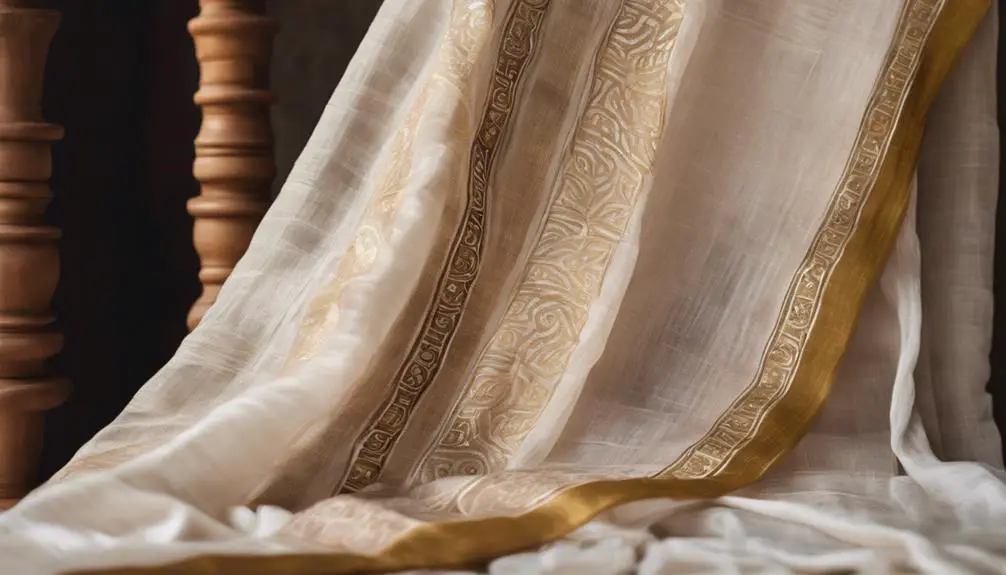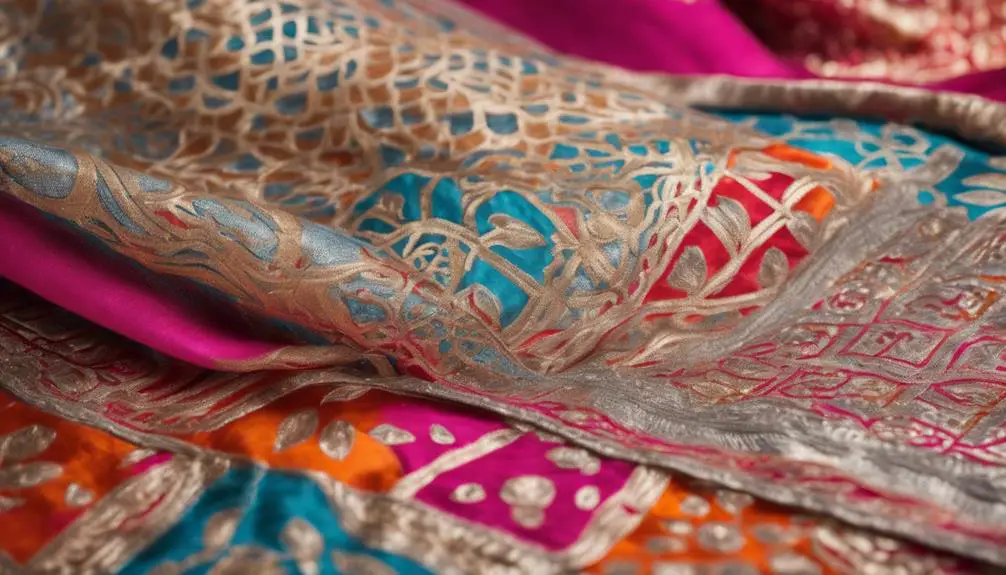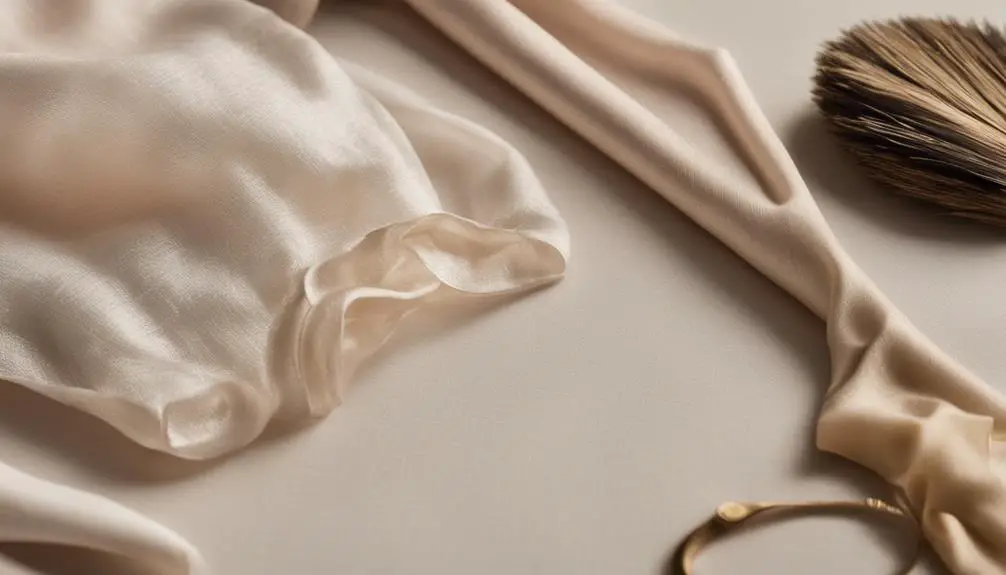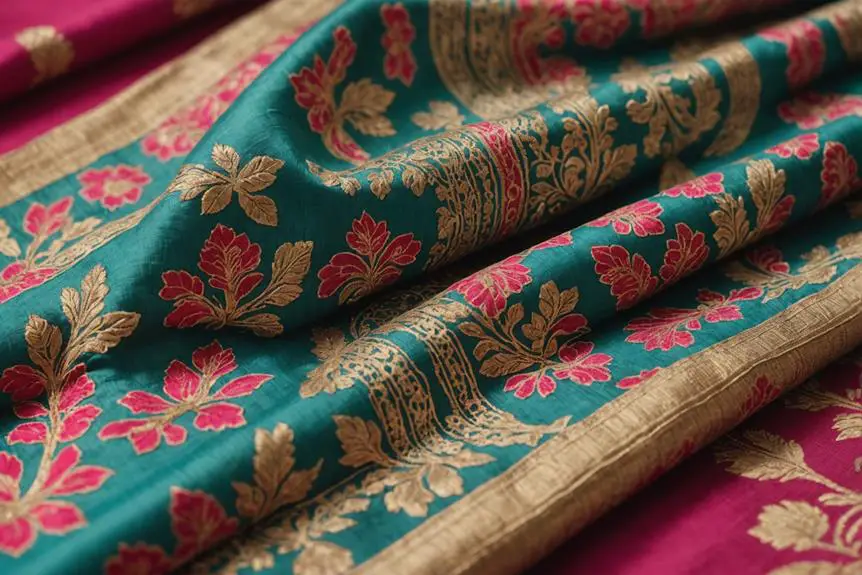When you're trying to identify Chanderi fabric, you'll want to focus on a few key characteristics that set it apart. Look for its lightweight, sheer texture and glossy finish, which contribute to its luxurious drape. Authentic pieces also showcase intricate handwoven motifs, or buttis, often inspired by nature. But how can you guarantee you're not just admiring a replica? Understanding the nuances of weaving techniques and the importance of trusted retailers can make all the difference. Let's explore what to watch for next to guarantee you're making an informed choice.
Characteristics of Chanderi Fabric

When you explore the characteristics of Chanderi fabric, you'll immediately notice its lightweight and sheer texture, which gives it a luxurious drape and a glossy transparency. Isn't that just dreamy? This fabric is traditionally woven using a blend of pure silk and cotton Zari on cotton yarns, making it feel oh-so-special. You might be wondering, what's Zari? It's that shiny thread that adds a touch of elegance and sparkle!
Chanderi fabric comes in three main types: pure silk, silk-cotton blend, and Chanderi cotton. Each has its own charm and is perfect for different occasions. Whether you're dressing up for a wedding or just want something stylish for a casual outing, there's a Chanderi option for you!
What really sets Chanderi apart are the intricate handwoven motifs known as booties. These little designs often sparkle with gold, silver, or copper dust, making each piece look like a work of art. Plus, the sheer texture of the fabric is due to single flature yarns, which enhances its shine while keeping it delicate.
Recognizing Authenticity
Identifying authentic Chanderi fabric can be a delightful experience if you know what to look for. This lightweight, sheer quality fabric is a treasure, but spotting the genuine stuff takes a keen eye. Here's how to recognize authenticity:
- Look for Irregularities: Genuine handwoven pieces often have slight uneven textures. Don't worry; these irregularities are signs of traditional craftsmanship and add character to your fabric!
- Check the Sheen: Authentic Chanderi has a glossy appearance, thanks to the fine quality silk and Zari used in weaving. If it catches the light just right and glimmers, you're likely onto something special.
- Examine the Motifs: Look for intricate booties or motifs inspired by nature. These traditional designs are hallmark features of authentic Chanderi fabric. If you see those lovely details, you're on the right track!
When shopping, make sure you buy from trusted retailers, like Fashinza, who focus on genuine handloom products. After all, who wants to end up with a fake? So, next time you're on the hunt for Chanderi, keep these tips in mind. You'll be able to spot authentic Chanderi fabric faster than you can say "handwoven." And trust me, once you find the real deal, you'll appreciate its elegance and craftsmanship even more! Happy fabric hunting!
Unique Motifs and Designs

Chanderi fabric's unique motifs and designs are a mesmerizing reflection of its rich heritage and contemporary appeal. When you look closely, you'll notice the intricate handwoven motifs, known as buttis. These beauties are created using various needle techniques, often inspired by nature. Think peacocks and flowers that dance across the fabric!
But it doesn't stop there. Modern Chanderi designs blend traditional designs with contemporary patterns, showcasing geometric shapes and vibrant illustrations that mirror today's fashion trends. Isn't that cool? The shimmering texture of Chanderi fabric adds a luxurious touch, especially when you see how the motifs are often coated in gold, copper, or silver dust. Talk about elegance!
These traditional motifs aren't just pretty to look at; they carry cultural significance too. They represent local folklore and heritage, making every piece a story waiting to be told. Plus, the evolution of these motifs means you'll find a diverse range of color palettes. Gone are the days of just pastel shades; now, bold, vibrant combinations are all the rage.
Weaving Techniques
If you've ever marveled at the lightweight elegance of Chanderi fabric, it's the weaving techniques that truly set it apart. This fabric's magic lies in the combination of high-quality cotton yarn and pure Chanderi silk, creating a luxurious texture that feels heavenly against your skin. The traditional handwoven Chanderi showcases intricate motifs, adding to its charm.
Here are three key weaving techniques that make Chanderi special:
- Non-Degumming Process: This technique enhances the fabric's shine and transparency, giving it that glowing appearance you can't resist.
- Single Flature Yarn: Using this yarn during weaving contributes to the delicate drape and sheer quality that Chanderi is known for.
- Hand-Loomed Motifs: The buttis, or motifs, are created using various needle techniques. These aren't just patterns; they reflect the craftsmanship and love that goes into every authentic Chanderi silk saree.
You'll notice that even though some modern designs have crept in, the essence of Chanderi remains its intricate handwoven details. The weaving techniques not only uphold tradition but also breathe life into each piece, making every saree unique. So next time you admire a Chanderi fabric, remember, it's not just a pretty face; it's the result of time-honored techniques that make it a treasure in the textile world!
Care and Maintenance Tips

Caring for your Chanderi fabric guarantees its beauty lasts for generations. This traditional fabric deserves a little extra TLC to keep it looking fabulous. Ideally, you should opt for dry cleaning. It's the best way to preserve its delicate zari work and overall texture. But if you find yourself in a jam and need to machine wash, use cold water with a mild detergent and a gentle cycle. Trust me, your Chanderi fabric will thank you!
When it comes to drying, avoid direct sunlight like the plague! Sunlight can fade those vibrant colors and weaken the fibers, turning your stunning outfit into a shadow of its former self. Instead, lay it flat in a shaded area to dry naturally.
Now, let's talk about ironing. You want to look sharp, but be careful! Use a low heat setting, and place a cloth between the iron and your fabric. This prevents those pesky scorches on the delicate threads. And here's a pro tip: steer clear of applying deodorants or fragrances directly on the fabric. You wouldn't want stains and discoloration ruining your gorgeous ensemble!
Frequently Asked Questions
How to Identify Chanderi?
You're diving into the world of Chanderi, huh? That's awesome! To spot genuine Chanderi, look for its unique sheen and handwoven patterns. Ever noticed the intricate designs like peacocks? Those are classic! Plus, it's got a bit of a rough feel, thanks to the raw cotton. When you buy, keep an eye on the pricing—authentic pieces can be a bit pricier. Don't forget to care for it right, so it lasts!
What Are the Characteristics of Chanderi Fabric?
Chanderi fabric's got a rich history, right? You'll love its lightweight feel and gorgeous draping! Look for those stunning Chanderi patterns and vibrant colors that pop. When you check out Chanderi weaving, notice the craftsmanship by skilled artisans who pour their heart into each piece. Don't forget, caring for it is key to keeping those trends alive. Whether you're dressing up or down, Chanderi's perfect for any occasion! Isn't that awesome?
How Can You Tell the Difference Between Chanderi Silk and Pure Silk?
You can tell the difference between Chanderi silk and pure silk by checking the fabric texture. Chanderi weave often feels slightly rough and has that unique lightweight translucency. Look for Chanderi motifs and intricate designs that traditional weavers create. Plus, Chanderi usually has a lower price point! When you're shopping, keep an eye on dyeing techniques and market trends. Trust me, knowing these little details makes all the difference in fashion applications!
What Is the Difference Between Chanderi and Cotton?
So, you're curious about the difference between Chanderi and cotton, huh? Well, Chanderi's got a rich history tied to skilled artisans who weave intricate patterns and use vibrant colors. It's lightweight and sheer, thanks to unique production methods. Cotton, on the other hand, is thicker and more matte. If you want to care for your Chanderi, remember, it needs a gentle touch! Isn't it fascinating how these fabrics reflect their origins?
Conclusion
So, there you have it! Identifying Chanderi fabric isn't rocket science, right? Just remember to check for that lightweight feel, shiny single yarns, and those beautiful motifs. If you see those unique patterns, you're probably on the right track! And hey, always buy from trusted spots to snag the real deal. Ready to rock that gorgeous Chanderi look? Trust me, you'll love the way it drapes and shines. Happy shopping!




